ISS: Meteor
Science
ISS Utilization: Meteor (Meteor Composition Determination) Camera
Meteor is a new ISS camera with the goal of making the first spaceborne observations of the chemical composition of meteors entering Earth's atmosphere. Meteors are relatively rare, and are difficult to monitor from the ground because of the interference created by Earth's atmosphere. The Meteor investigation takes high-resolution video and images of the atmosphere and uses a software program to search for bright spots, which can later be analyzed on the ground.
The mission objective is to fly a visible spectroscopy instrument to the ISS for the primary purpose of observing meteors in Earth orbit. Meteor uses image analysis to provide information on the physical and chemical properties of the meteoroid dust, such as size, density, and chemical composition. Since the parent comets or asteroids for most of the meteor showers are identified, the study of the meteoroid dust on orbit provides information about the parent comets and asteroids. Meteor plans to operate for 2 years (as allowed by science priorities) in the WORF (Window Observational Research Facility) volume. 1)
Note: The original Meteor camera was already a payload of the Cygnus CRS Orb-3 mission of Orbital ATK which suffered a catastrophic anomaly moments after launch on October 26, 2014. This event impacted the research and supplies aboard the ISS, including the Meteor investigation.
Background
Spaceborne viewing of meteor showers offers many advantages over traditional observation by ground- or aircraft-based instruments. Viewing from the ISS is not affected by weather or interference from Earth's atmosphere. Instruments on Earth are also limited to short periods of observation time and viewing field, but the camera aboard the station will record for roughly 560 minutes every day. That is the amount of time the station is in darkness as it orbits Earth 16 times a day. 2)
Partners in the Meteor investigation include CASIS (Center for the Advancement of Science in Space) with its administrative office in Melbourne, FL, USA, SwRI (Southwest Research Institute), San Antonio, Texas, USA and Japan's CIT/PERC (Chiba Institute of Technology/Planetary Exploration Research Center), Narashino-city, Japan. The Meteor camera has been developed by CIT/PERC. NASA and the NL (National Laboratory) are sponsoring the Meteor project.
Once installed, the Meteor system will operate mostly on its own. Michael Fortenberry, PI (Principal Investigator) for Meteor at SwRI, explains that the crew will only need to adjust the lens focus and change out hard drives that store high-resolution video collected by the camera. A software program will identify and separate video clips that likely include meteors, and those can be further analyzed later on the ground. Scientists can use these images to glean information such as the size of a particle of meteoric dust based on its flight path and light curve.
Going beyond identifying meteors and monitoring their activity, the instrument has the additional capability to help classify their chemical composition. A device on the camera called a diffraction grating separates light passing through it into different wavelengths or colors, known as spectra, just as a prism does. The device will record spectra of light emitted for specific meteoroids, which investigators can use to determine the abundance of several elements in the meteoroids or meteor dust.
"From previous observation on the ground, we already know the parent body for these meteors," explains Meteor Co-PI Tomoko Arai at PERC. "The spectral information will tell us more about these parent bodies and help us understand their materials."
The camera is scheduled to record all 12 known major showers. Secondary targets include minor meteor showers and periods with little or no identified regular activity. Observation of de-orbiting spacecraft and other targets also will be made. "There is a chance we could find new minor meteor showers, or observe meteors from an unexpected source like Comet Ison," says Fortenberry.
Meteors are created by the disintegration of comets or asteroids orbiting the sun. Those that enter Earth's atmosphere heat up and burn, causing the visible streak we see during a shower. Although the exact number of meteors entering the atmosphere varies during each event, some major showers can produce a peak of more than 100 visible meteors per hour.
Some meteor-producing bodies have the potential to create meteors so large that they do not burn up completely on their trip through Earth's atmosphere and actually strike the surface. This investigation will collect much more data than was previously possible about what already hits our planet. This data will be correlated with information from other sensors and analysis to determine how many meteors are entering the atmosphere and their characteristics. Those characteristics will help scientists better understand which parent bodies might create meteors that pose a threat to Earth, along with their physical and chemical makeup. In addition, data on orbital debris, both natural and man-made, can be used to time and position spacecraft to keep them safe from collisions in space.
The WORF (Window Observational Research Facility) onboard the ISS provides a stable platform for hand-held photography and other research activities at the U.S. Laboratory Science Window, the highest optical-quality window ever installed on a human space vehicle. The Window enables the use of high-resolution cameras from inside the station rather than outside, where instruments are subject to the vacuum and extreme temperatures of space.
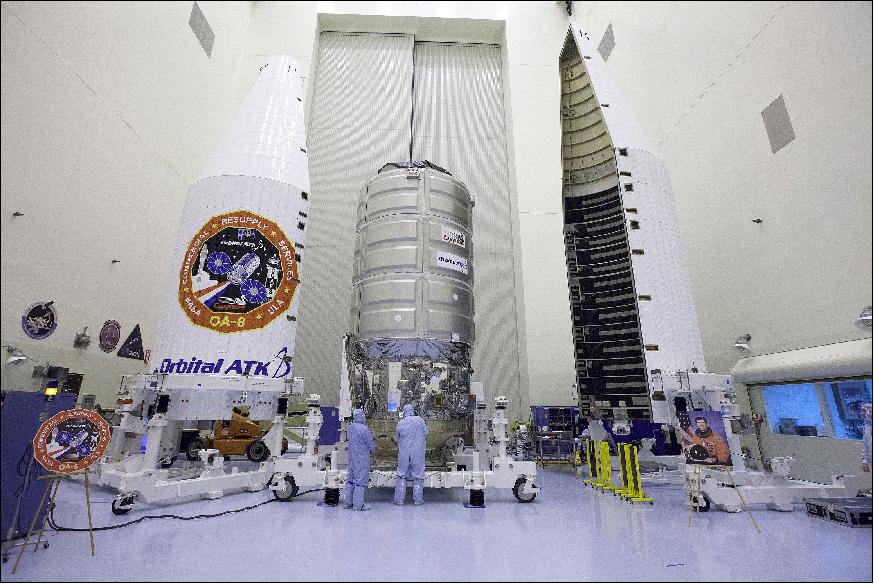
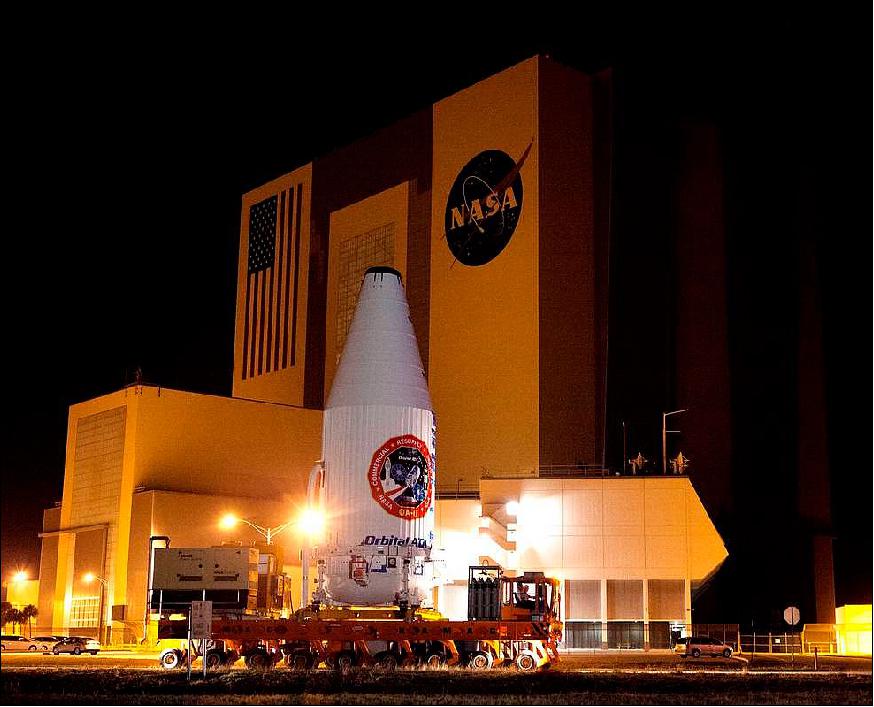
Launch
The Meteor camera, as part of the Cygnus CRS OA-6 cargo of the commercial OA (Orbital ATK) mission to the ISS, was launched on March 23, 2016 (03:05:51UTC) atop a ULA (United Launch Alliance) Atlas-5 vehicle. The launch site was Cape Canaveral SLC-41 (Satellite Launch Complex-41). This was the second flight of an enhanced Cygnus spacecraft to the ISS and the fifth of ten flights by Orbital ATK under the Commercial Resupply Services contract with NASA. 3) 4)
Cygnus spacecraft are named after former astronauts. OA-6 is named the SS Rick Husband, after the commander of Space Shuttle Columbia's ill-fated STS-107 mission. Husband was killed on February 1, 2003 when the Columbia space shuttle disintegrated as she reentered Earth's atmosphere at the end of a two-week microgravity research mission. None of the seven astronauts aboard survived.
Orbit: The near-circular orbit of the ISS is at a nominal altitude of ~400 km with an inclination of 51.6º.
Cygnus carried a payload of 3513 kg of science and research, crew supplies and vehicle hardware to the orbital laboratory to support dozens of science and research investigations that will occur during Expeditions 47 and 48. 5)
The Cygnus spacecraft will arrive at the station on March 26, at which time Expedition 47 Commander Tim Kopra of NASA and Flight Engineer Tim Peake of ESA (European Space Agency) will grapple Cygnus, using the space station's robotic arm. After Cygnus capture, ground commands will be sent from mission control in Houston to the station's arm to rotate and install the spacecraft on the bottom of the station's Unity module. Cygnus will remain at the space station until May, when the spacecraft will be used to dispose of several tons of trash during its fiery reentry into Earth's atmosphere.
A few of the scientific highlights: 6) 7)
• Gecko Gripper, testing a mechanism similar to the tiny hairs on geckos' feet that lets them stick to surfaces using an adhesive that doesn't wear off.
• Meteor, an instrument to evaluate from space the chemical composition of meteors entering Earth's atmosphere. The instrument is being re-flown following its loss on earlier supply missions.
• Saffire, which will set a large fire inside the Cygnus in an unprecedented study to see how large fires behave in space. The research is vital to selecting systems and designing procedures future crews of long-duration missions can use for fighting fires.
• Strata-1 to study regolith behavior in microgravity (to investigate how easy or difficult it is to anchor a spacecraft in regolith). The Strata-1 experimental facility exposes a series of regolith simulants, including pulverized meteorite material, glass beads, and regolith simulants composed of terrestrial materials and stored in multiple transparent tubes, to prolonged microgravity on the space station.
• AMF (Additive Manufacturing Facility) of Made In Space Inc. of Mountain View, CA will be installed as a permanent AM (Additive Manufacturing) 3D printing device in an Express Rack. The AMF uses this technology to enable the production of components on the space station for both NASA and commercial objectives.
• In addition, Cygnus is carrying more than two dozen CubeSats/nanosatellites that will be ejected from either the spacecraft or the station at various times during the mission to evaluate a range of technology and science including Earth observations.
• Diwata-1 is a microsatellite (50 kg) of the University of the Philippines.
Meteor Camera
The Meteor camera is equipped with IR cut filer, which provides visible light only, up to 700 nm. The visible light is sufficient for spectral analyses to obtain the meteors' elemental composition, because the atomic emission lines of major elements are located within the visible wavelengths as follows (Ref. 1):
• Fe (370 nm)
• Ca (393 nm)
• Mg (518 nm)
• Na (589 nm)
The WORF window has limited (~21%) transmittance at the 370 nm wavelength but is still useful for this study. On-orbit, there are no distortions caused by weather and atmospheric disturbances which affect ground-based observation. Therefore, flux data collected on-orbit allows for better comparison of data from observed meteor showers. The objectives for the Meteor payload include:
• Primary: The periods around the peak of major meteor showers are the highest priority for observations.
• Secondary:
- Periods outside of the peak of major meteor
- Minor meteor showers
- Periods with little or no regular meteor activity identified
• Tertiary (Targets of Opportunity)
- Observation of de-orbiting spacecraft
- Daytime terrestrial targets at the request of NASA.
Operational requirements: Meteor is to be operational onboard the ISS, installed in the WORF ( Window Observational Research Facility) rack, for a two year period. Meteor makes observations during the night portion of each ISS orbit, and plans to operate during periods of predicated and well known meteor showers.
Operational protocols: Meteor, mounted inside the WORF, utilizes the Destiny module nadir window for Earth viewing. Crew activities include installation, lens changeout, hard drive changeout, and a brief focus activity. When configured onboard, Meteor operations are fully autonomous. The Meteor team, located in Chiba, Japan, performs mission planning; coordinates with the Payload Operations Center at the NASA/MSFC (Marshall Space Flight Center); and uses STELLA ( Software Toolkit for Ethernet Lab-Like Architecture) to generate commands and retrieve data for Meteor onboard operations.
Meteor observations: 8)
Meteor showers occur when the Earth's orbit crosses meteoroid streams which are mainly derived from comets. When a comet approaches to the Sun in its orbit, meteoroids spread out along the orbit of the comet due to vaporization of ice, resulting in a meteoroid stream. Also, it has been recently shown that short-period meteor showers are not generated from the water vapor drag of active comets, but rather the result of infrequent disintegrations of comet-asteroid transition bodies. Such examples are the Geminids and Quadrantids, which originated from a breakup of asteroids 3200 Phaethon and 2003 EH1, respectively. Major meteor showers annually occur in the known specific timeframe. Possible parent bodies which are dynamically linked with the major meteor showers are identified (Table 1).
Meteor shower | Active window (peak day) | Velocity | ZHR (Zenithal Hourly Rate) | Planet body |
Quadrantids | 01/01-01/05 (1/3) | 41 km/s | 120 | Asteroid 2003 EH1, Comet 1490Y1 |
April Lyrids | 04/16-04/25 (4/22) | 49 km/s | 18 | Comet Thatcher |
η-Aquarids | 04/19-05/28 (5/5) | 66 km/s | 60 | Comet1P/Halley |
Southern δ-Aquarids | 07/12-08/19 (7/28) | 41 km/s | 20 | Comet1P/Halley |
Perseids | 07/17-08/24 (8/12) | 59 km/s | 100 | Comet 109P/Swift-Tuttle |
October Draconids | 10/06-10/10 (10/8) | 20 km/s | variable | Comet 21P/Giacobini-Zinner |
Orionids | 10/02-11/07 (10/21) | 66 km/s | 23 | Comet 1P/Halley |
Southern Taurids | 09/25-11/25 (11/5) | 27 km/s | 5 | Asteroid 2004TG10 |
Northern Taurids | 09/25-11/25 (11/12) | 29 km/s | 5 | Comet 2P/Encke |
Leonids | 11/10-11/23 (11/17) | 71 km/s | Variable | Comet 55P/Tempel-Tuttle |
Geminids | 12/07-12/17 (12/14) | 35 km/s | 120 | Asteroid 3200Phaethon |
Urisids | 12/17-12/26 (12/22) | 33 km/s | 10 | Comet 8P/Tuttle |
Legend to Table 1: ZHR (Zenithal Hourly Rate) represents the number of meteors a single observer would see in one hour under a clear, dark sky if the radiant of the shower were at the zenith.
Since the velocity of the meteoroids of each meteor shower is known (Table 1), the size of the meteoroid can be estimated based on its flight path and light curve. The chemical composition of the meteoroid can be determined by the emission spectra. Thus, observation of meteor showers is important in understanding the physical and chemical properties of not only meteoroids, but their parent comets or asteroids. These studies are also critical in planetary defense, because some meteor-parent asteroids, i.e. 3200 Phaethon are potentially hazardous asteroids, which have risk of meteor impacts on Earth.
To date, most meteor observations have been performed on the ground. They are weather dependent and limited to a narrow observation range. The ISS (International Space Station) is an ideal platform for continuous meteor observation without distortion caused by weather and atmospheric disturbances.
Meteor observation system — also referred to as COMETSS (Chitech Observatory of METor on iSS):
COMETSS is a super sensitive color HDTV (High Definifition Television) camera with a lens (F/ 0.94, f=17.5 mm, FOV of 46º) to be installed in the WORF of the pressurized US Lab Module (Destiny).

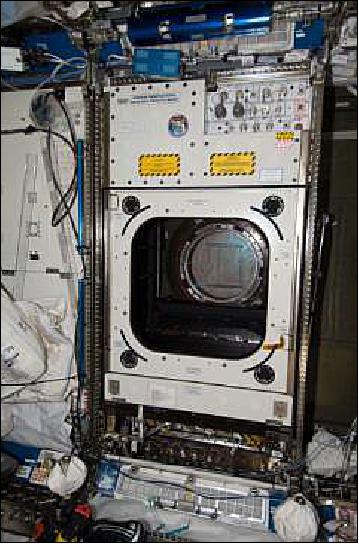
The reflective coating on the window absorbs UV radiation, but transmittance rises rapidly after 304 nm to > 90% in the visible and into the near infrared. The Meteor camera is equipped with IR cut filer, which provides visible light only, up to 700 nm. We will also install a transmitted diffraction grating in front of the lens for the spectral analyses of the meteoroids, to estimate meteors' elemental abundance. The atomic emission lines of major elements are located within the visible wavelength; Fe I (370 nm), Ca I (393 nm), Mg I (518 nm), Na I (589 nm). The flux data collected will allow better comparison of physical and chemical data among major meteor showers and their parent bodies.
Image sensor | HbCMOS (Hyper bit CMOS sensor) |
Sensor size | 2/3 type (9.6 mm x 5.4 mm) |
Valid pixels, pixel pitch | 1280(H) x 720(V), 7.5 µm |
Frame frequency | 30 fps (frames per second) |
Mount | Micro Four Thirds |
Mass, size, power consumption | 0.8 kg, 82 mm x 82 mm x 140 mm, 15 W |
FOV (Field of View) only with a lens | 28.4º (H) x 16.4º (V) |
FOV with a lens & wide-angle converter | 38.8º (H) x 22.8º (V) |
Operation and System Configuration
The ISS orbits the Earth for 90 minutes at an altitude of 400 km with an orbital inclination of 51.6º. The ISS night time where the Sun is beneath the horizon viewed from the ISS is about 35 minute in a single orbit. With the ISS orbiting the Earth sixteen times in one day, the available night time for the meteor observation is about 560 minutes. The FOV from the window is restricted due to other pressurized module, a robotic arms and docked launch vehicles (Figure5). Because of the relatively narrow FOV of the COMETSS (Table 2), the COMETSS will be installed normal to the window with a distance of 5-7.5 cm between the bumper ring attached to the lens and the window glass.
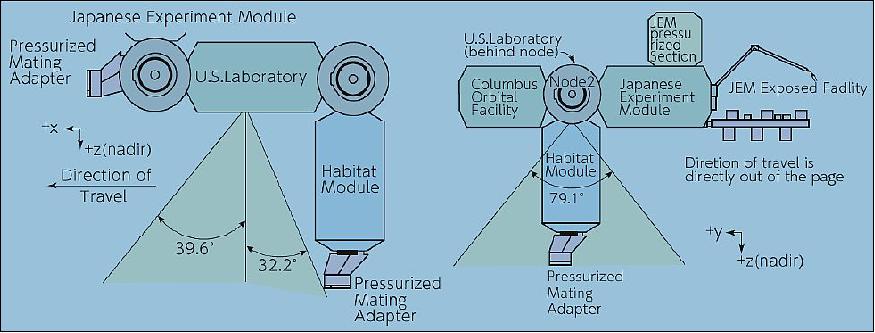
The COMETSS system consists of a Hyper bit CMOS sensor (HbCMOS) HDTV camera, a lense, an encoder, a power distribution box and a laptop PC (Figure 3). Except for the focus adjustment which is supported by the ISS crew, all the operation of the COMETSS is remotely conducted on the ground. Operation plan files are uploaded to the onboard laptop PC. The onboard software on the PC perform on/off of the camera and the encoder, and processing/analyze of the observation data, on the basis of the operation plan.
The operation time of the WORF rack will be shared with other payloads, such as ISS SERVIR ISERV (Environmental Research and Visualization) and the Sally Ride EarhKAM (Earth Knowledge Acquired by Middle Schools). With the shared operation timeframe, the observation targets are propritized: primary (periods around the peak of major meteor showers, secondary (periods outside of the peak of major meteor showers, minor meteor showers, and periods with little or no regular meteor activity identified), and tertinary as targest of opportunity (observation of de-orbiting spacecraft, and daytime terrestrial targets upon the request of NASA).
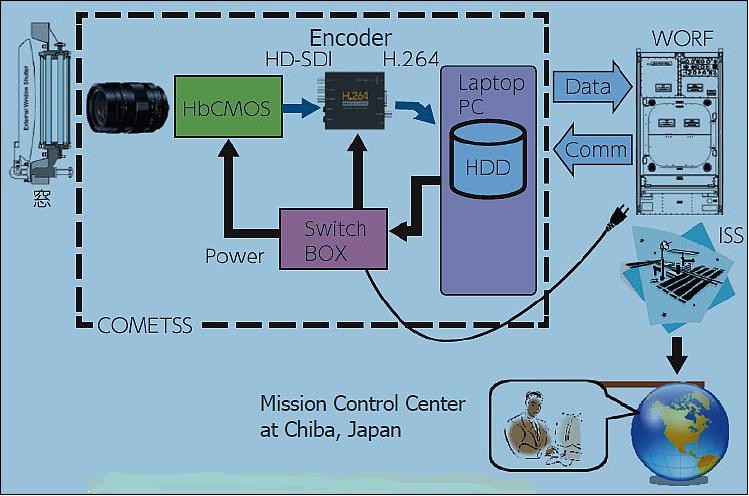
Data Analysis and Handling
Due to the constraint of the maximum downlinkable data volume of 200 MB/day from the ISS, all the acquired data can not be downlinked. A software is being developed for autonomous detection of meteors in the acquired image data, and extraction of the data including meteor images, so that the image with meteors can only be downlinked and the downlinked data volume can be minimized. The project may also lower the bit rate of the data to further decrease the downlikned data volume. The downlinked data will be analyzed for scientific interests, and will be openly distributed via Internet for the purpose of education and public outreach.
Mission Status
• April 27, 2023: The International Space Station (ISS) partners have agreed to extend the operational period of the ISS. The United States, Japan, Canada and participant European Space Agency (ESA) countries will support operations until 2030, while Russia has committed to continuing station operations until 2028. 10)
• August 2016: Night-sky enthusiasts have been stepping outside this week to witness the annual light show from the Perseid meteors. The 2016 shower was predicted to display as many as 200 meteors per hour at its peak on August 11-12. But whatever the shower's intensity, you won't see anything if the view is obscured by clouds. A clear view is one reason that some scientists are interested in looking down instead of up—from the vantage point of the ISS (International Space Station). 9)
- The Meteor Observation on ISS (Meteor) project, led by Michael Fortenberry of SwRI ( Southwest Research Institute), is providing that downward-looking view. The image of Figure 7 is a composite of frames captured by Meteor's high sensitivity, high-definition TV camera installed in the space station's WORF (Window Observational Research Facility). The image was acquired on July 30, 2016, during the Delta Aquarids, a meteor shower that precedes the Perseids each summer. — The Meteor project's camera made its first observations on July 7, 2016. This scene shows a very bright meteor, or fireball, as it heats up and burns in Earth's atmosphere. The green streak behind the meteor is a plasma trail. The meteor was spotted over the North Pacific Ocean (about 173.9E, 48.5N).
- "The Meteor team is very excited to start making observations on the ISS," said co-investigator Tomoko Arai of Japan's PERC/CIT (Planetary Exploration Research Center / Chiba Institute of Technology). "We will focus on photometric observations for the first year. In our second year, spectroscopic observations will be made."
- The Meteor instrument includes a device called a diffraction grating, which uses spectroscopy to collect information about the meteor's composition. By collecting this information from above, there is less atmosphere to distort the view and better information about the elemental composition of individual meteors.
- "We have a pretty good understanding of composition based on meteorites we've collected on ground, but most meteors don't make it to the ground," said William Stefanov of NASA/JSC (Johnson Space Center), and Associate ISS Program Scientist for Earth Observations. "Measurements from the Meteor project can be used to relate composition back to their parent bodies. On some level, that lets us test the validity of our understanding built from meteorites collected at Earth's surface."
![Figure 7: This Meteor image was acquired on July 30, 2016, during the Delta Aquarids, a meteor shower that precedes the Perseids each summer [the image was provided by Tomoko Arai of Japan's PERC/CIT (Planetary Exploration Research Center/Chiba Institute of Technology). Caption by Kathryn Hansen. The Meteor investigation partners include the CASIS (Center for the Advancement of Science in Space), SwRI (Southwest Research Institute) in San Antonio, TX, and Japan's PERC (Planetary Exploration Research Center) at CIT]](/api/cms/documents/163813/2569929/ISSMeteor_Auto0.jpeg)
References
1) Michael Fortenberry, "Meteor Composition Determination (Meteor)," NASA, January 20, 2016, URL: http://www.nasa.gov/mission_pages/station/research/experiments/1323.html
2) Melissa Gaskill, "Monitoring Meteor Showers From Space," NASA, July 31, 2015 (update), URL: http://www.nasa.gov/mission_pages/station/research/news/meteors_from_space
3) Cheryl Warner, Dan Huot, "NASA Sends Fire, Meteor Experiments to International Space Station on Commercial Cargo Spacecraft," NASA, Release 16-036, March 23, 2016, URL: http://www.nasa.gov/press-release/nasa-sends-fire-meteor-experiments-to-international-space-station-on-commercial-cargo
4) Steven Siceloff, "Cygnus Cargo Ship, Atlas V Blaze Path to Station," NASA, March 23, 2016, URL: http://www.nasa.gov/feature/cygnus-cargo-ship-atlas-v-blaze-path-to-station
5) Kathryn Hambleton, Tracy Young, "NASA TV Coverage Set for Fifth Orbital ATK Resupply Mission to Space Station," NASA, March 17, 2016, URL: http://www.nasa.gov/press-release/nasa-tv-coverage-set-for-fifth-orbital-atk-resupply-mission-to-space-station-0
6) Steven Siceloff, "Cygnus Set to Deliver Its Largest Load of Station Science, Cargo," NASA, March 18, 2016, URL: http://www.nasa.gov/feature/cygnus-set-to-deliver-its-largest-load-of-station-science-cargo
7) "Sticky, stony and sizzling science launching to space station," Science Daily, Source NASA/JSC, March 9, 2016, URL: https://www.sciencedaily.com/releases/2016/03/160309140040.htm
8) T. Arai, M. Kobayashi, M. Yamada, T. Matsui, and COMETSS project team, PERC (Planetary Exploration Research Center), Chiba Institute of Technology, "Meteor observation HDTV camera onboard the International Space Station," 45th Lunar and Planetary Science Conference (2014),45th LPSC (Lunar and Planetary Science Conference), The Woodlands, TX, USA, March 17-21, 2014, paper: 1610.pdf, URL: http://www.hou.usra.edu/meetings/lpsc2014/pdf/1610.pdf
9) "A Space-Based View of Meteor Showers," NASA Earth Observatory, Aug. 13, 2016, URL: http://earthobservatory.nasa.gov/IOTD/view.php?id=88578
10) Garcia, Mark. “Partners Extend International Space Station for Benefit of Humanity – Space Station.” NASA Blogs, 27 April 2023, https://blogs.nasa.gov/spacestation/2023/04/27/partners-extend-international-space-station-for-benefit-of-humanity/
The information compiled and edited in this article was provided by Herbert J. Kramer from his documentation of: "Observation of the Earth and Its Environment: Survey of Missions and Sensors" (Springer Verlag) as well as many other sources after the publication of the 4th edition in 2002. - Comments and corrections to this article are always welcome for further updates (eoportal@symbios.space).